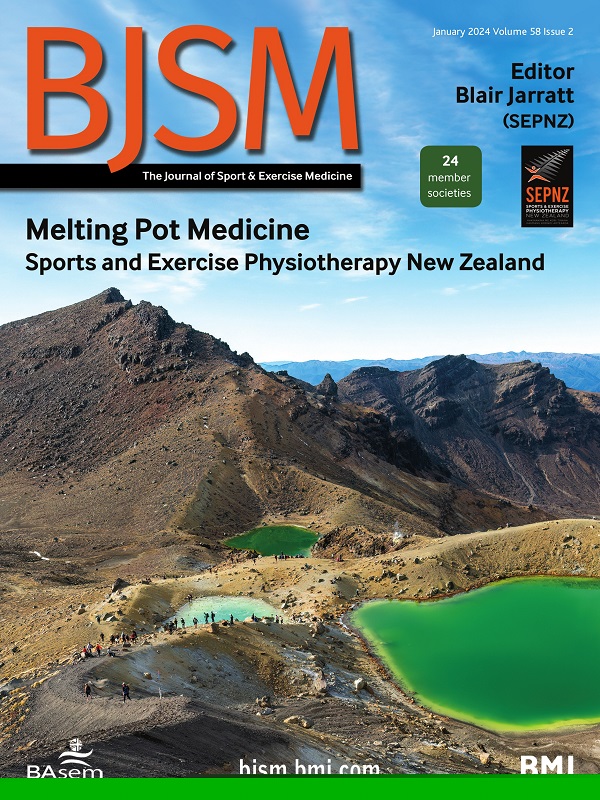Injury-inciting circumstances of sudden-onset hamstring injuries: video analyses of 63 match injuries in male professional football players in the Qatar Stars League (2013–2020)
IF 11.6
1区 医学
Q1 SPORT SCIENCES
引用次数: 0
Abstract
Objective To describe and categorise the injury-inciting circumstances of sudden-onset hamstring match injuries in professional football players using systematic video analysis. Methods Using a prospective injury surveillance database, all sudden-onset hamstring match injuries in male football players (18 years and older) from the Qatar Stars League between September 2013 and August 2020 were reviewed and cross-referenced with broadcasted match footage. Videos with a clear observable painful event (ie, a player grabbing their posterior thigh) were included. Nine investigators independently analysed all videos to describe and categorise injury-inciting circumstances. We used three main categories: playing situation (eg, time of injury), player action(s) (eg, running) and other considerations (eg, contact). Player action(s) and other considerations were not mutually exclusive. Results We included 63 sudden-onset hamstring match injuries out of 295 registered injuries between 2013 and 2020. Running was involved in 86% of injuries. Hamstring injuries occurred primarily during acceleration of 0–10 m (24% of all injuries) and in general at different running distances (0–50 m) and speeds (slow to fast). At 0–10 m distance, indirect player-to-player contact and inadequate balance were involved in 53% and 67% of the cases, respectively. Pressing occurred in 46% of all injuries (injured player pressing opponent: 25%; being pressed by opponent: 21%) and frequently involved player-to-player contact (69% of the cases when the injured player was pressing vs 15% of the cases when the opponent was pressing) and inadequate balance (82% vs 50%, respectively). Other player actions that did not involve running (n=9, 14% of all injuries) were kicking (n=6) and jumping (n=3). Conclusion The injury-inciting circumstances of sudden-onset hamstring match injuries in football varied. The most common single-player action (24%) was acceleration over a distance of <10 m. Pressing, inadequate balance and indirect contact were frequently seen player actions. Injury prevention research in football should look beyond high-speed running as the leading risk factor for sudden-onset hamstring injuries. Data are available upon reasonable request. Data may be obtained from a third party and are not publicly available. Not applicable.突发性腿筋损伤的诱发因素:对卡塔尔明星联赛(2013-2020 年)中男性职业足球运动员在 63 场比赛中受伤的视频分析
目的 通过系统的视频分析,对职业足球运动员在比赛中突发腿筋损伤的诱发因素进行描述和分类。方法 利用前瞻性损伤监测数据库,对 2013 年 9 月至 2020 年 8 月期间卡塔尔明星联赛中所有男性足球运动员(18 岁及以上)在比赛中突发的腿筋损伤进行回顾,并与转播的比赛录像进行交叉对比。有明显可观察到的疼痛事件(即球员抓住大腿后侧)的视频都被包括在内。九名调查人员对所有视频进行了独立分析,对导致受伤的情况进行了描述和分类。我们使用了三个主要类别:比赛情况(如受伤时间)、球员动作(如奔跑)和其他考虑因素(如接触)。球员动作和其他考虑因素并不相互排斥。结果 在 2013 年至 2020 年登记的 295 例腿部肌肉损伤中,我们共纳入了 63 例突发腿筋损伤。86%的损伤涉及跑步。腿筋损伤主要发生在 0-10 米的加速跑过程中(占所有损伤的 24%),一般发生在不同的跑步距离(0-50 米)和速度(从慢到快)。在 0-10 米的距离上,分别有 53% 和 67% 的情况涉及球员与球员之间的间接接触和平衡不足。在所有受伤案例中,有 46%涉及压迫(受伤球员压迫对手:25%;被对手压迫:21%),并且经常涉及球员与球员之间的接触(受伤球员压迫对手的案例占 69%,而对手压迫受伤球员的案例占 15%)和平衡不足(分别占 82%和 50%)。其他不涉及奔跑的球员动作(9 人,占受伤总人数的 14%)包括踢球(6 人)和跳跃(3 人)。结论 足球比赛中突发腿筋损伤的诱因各不相同。最常见的单人动作(24%)是距离小于 10 米的加速。压迫、平衡不足和间接接触也是经常出现的球员动作。足球运动中的损伤预防研究不应将高速奔跑视为突发性腿筋损伤的主要风险因素。如有合理要求,可提供数据。数据可能来自第三方,不公开。不适用。
本文章由计算机程序翻译,如有差异,请以英文原文为准。
求助全文
约1分钟内获得全文
求助全文
来源期刊
CiteScore
27.10
自引率
4.90%
发文量
217
审稿时长
3-8 weeks
期刊介绍:
The British Journal of Sports Medicine (BJSM) is a dynamic platform that presents groundbreaking research, thought-provoking reviews, and meaningful discussions on sport and exercise medicine. Our focus encompasses various clinically-relevant aspects such as physiotherapy, physical therapy, and rehabilitation. With an aim to foster innovation, education, and knowledge translation, we strive to bridge the gap between research and practical implementation in the field. Our multi-media approach, including web, print, video, and audio resources, along with our active presence on social media, connects a global community of healthcare professionals dedicated to treating active individuals.

 求助内容:
求助内容: 应助结果提醒方式:
应助结果提醒方式:


